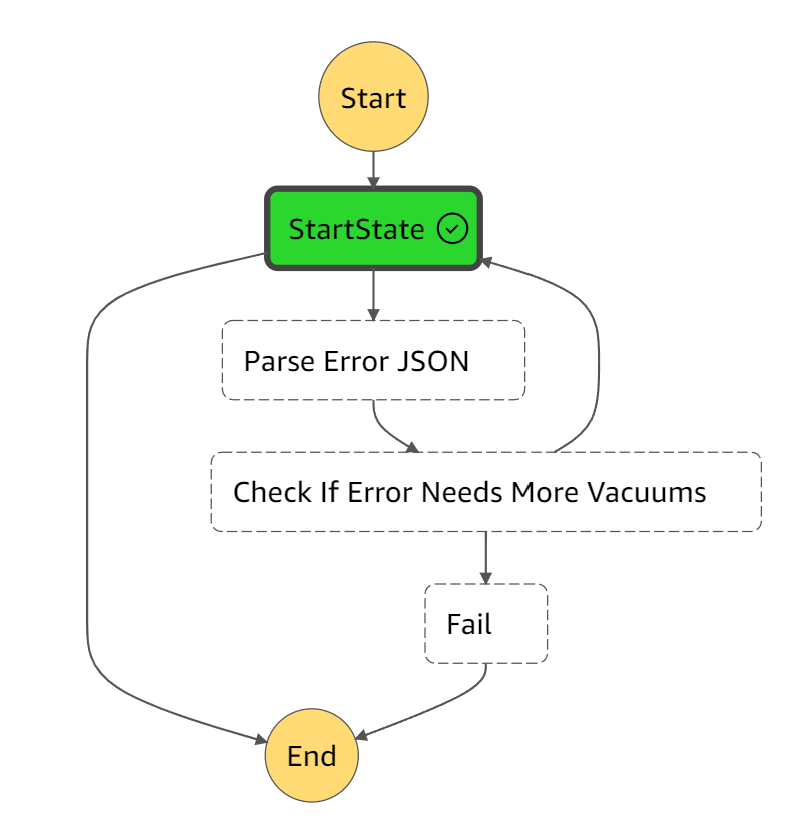Vacuuming Amazon Athena Iceberg with AWS Step Functions

In this post, we will look at how to resolve ICEBERG_VACUUM_MORE_RUNS_NEEDED errors by using AWS Step Functions to retry vacuuming Amazon Athena Iceberg tables until they are clean.
The Problem
Right now, running the VAACUUM command on a heavily updated Amazon Athena Icerberg table will result in the following error:
ICEBERG_VACUUM_MORE_RUNS_NEEDED: Removed 1000 files in this round of vacuum, but there are more files remaining. Please run another VACUUM command to process the remaining filesThe rationale for this behaviour is still a bit unclear, and it is not clear if this will be fixed in the future (if this unanswered repost.aws question is anything to go by).
The Solution
A solution I have come across in the wild is to simply run the vacuum command again until it succeeds. This is a bit of a hacky solution, but it works. I came across this solution from Matano and my team has implemented a similar solution in our own codebase.

The following is a CloudFormation template that will create a Step Function state machine that will run the vacuum command until it succeeds. The state machine will run every hour.
AWSTemplateFormatVersion: '2010-09-09'
Description: A CloudFormation template to create IAM role, policy, Step Functions, and CloudWatch event rule and target for table ingestion maintenance vacuum
Parameters:
WorkgroupName:
Type: String
Default: primary
Description: The name of the Athena Workgroup
DatabaseName:
Type: String
Default: default
Description: The name of the database
TableName:
Type: String
Description: The name of the Iceberg table
BucketName:
Type: String
Description: The name of the S3 bucket used for your Iceberg table
BucketPrefix:
Type: String
Default: ""
Description: The prefix for the S3 bucket used for your Iceberg table
AthenaOutputBucketName:
Type: String
Description: The name of the S3 bucket used for Athena query outputs
AthenaOutputBucketPrefix:
Type: String
Default: ""
Description: The prefix for the S3 bucket used for Athena query outputs
VacuumFrequency:
Type: String
Default: rate(1 hour)
Description: The frequency for the Iceberg vacuum
Conditions:
IsBucketPrefixSpecified: !Not [!Equals [!Ref BucketPrefix, ""]]
IsAthenaOutputBucketPrefixSpecified: !Not [!Equals [!Ref AthenaOutputBucketPrefix, ""]]
Resources:
StepFunctionRole:
Type: AWS::IAM::Role
Properties:
AssumeRolePolicyDocument:
Version: '2012-10-17'
Statement:
- Effect: Allow
Principal:
Service: 'states.amazonaws.com'
Action: 'sts:AssumeRole'
Condition:
ArnLike:
aws:SourceArn: !Sub 'arn:aws:states:${AWS::Region}:${AWS::AccountId}:stateMachine:*'
StringEquals:
aws:SourceAccount: !Ref AWS::AccountId
- Effect: Allow
Principal:
Service: 'events.amazonaws.com'
Action: 'sts:AssumeRole'
Condition:
ArnLike:
aws:SourceArn: !Sub 'arn:aws:events:${AWS::Region}:${AWS::AccountId}:rule/MaintenanceVacuumEventRule'
StepFunctionRolePolicy:
Type: AWS::IAM::Policy
Properties:
Roles: [!Ref StepFunctionRole]
PolicyName: StepFunctionRolePolicy
PolicyDocument:
Version: '2012-10-17'
Statement:
- Effect: Allow
Action:
- xray:PutTraceSegments
- xray:PutTelemetryRecords
- xray:GetSamplingRules
- xray:GetSamplingTargets
Resource: '*'
- Effect: Allow
Action: states:StartExecution
Resource:
- !Ref MaintenanceVacuumStateMachine
- Effect: Allow
Action:
- athena:startQueryExecution
- athena:stopQueryExecution
- athena:getQueryExecution
- athena:getDataCatalog
Resource:
- !Sub 'arn:aws:athena:${AWS::Region}:${AWS::AccountId}:workgroup/${WorkgroupName}'
- !Sub 'arn:aws:athena:${AWS::Region}:${AWS::AccountId}:datacatalog/*'
- !If
- IsBucketPrefixSpecified
- Effect: Allow
Action:
- s3:GetObject
- s3:PutObject
- s3:DeleteObject
- s3:ListBucket
Resource:
- !Sub 'arn:aws:s3:::${BucketName}'
- !Sub 'arn:aws:s3:::${BucketName}/${BucketPrefix}/*'
- Effect: Allow
Action:
- s3:GetObject
- s3:PutObject
- s3:DeleteObject
- s3:ListBucket
Resource:
- !Sub 'arn:aws:s3:::${BucketName}'
- !Sub 'arn:aws:s3:::${BucketName}/*'
- !If
- IsAthenaOutputBucketPrefixSpecified
- Effect: Allow
Action:
- s3:GetBucketLocation
- s3:GetObject
- s3:ListBucket
- s3:ListBucketMultipartUploads
- s3:ListMultipartUploadParts
- s3:AbortMultipartUpload
- s3:CreateBucket
- s3:PutObject
Resource:
- !Sub 'arn:aws:s3:::${AthenaOutputBucketName}'
- !Sub 'arn:aws:s3:::${AthenaOutputBucketName}/${AthenaOutputBucketPrefix}/*'
- Effect: Allow
Action:
- s3:GetBucketLocation
- s3:GetObject
- s3:ListBucket
- s3:ListBucketMultipartUploads
- s3:ListMultipartUploadParts
- s3:AbortMultipartUpload
- s3:CreateBucket
- s3:PutObject
Resource:
- !Sub 'arn:aws:s3:::${AthenaOutputBucketName}'
- !Sub 'arn:aws:s3:::${AthenaOutputBucketName}/*'
- Effect: Allow
Action:
- glue:GetDatabase*
- glue:UpdateTable
- glue:GetTable
- glue:GetTables
- glue:BatchDeleteTable
- glue:GetPartition*
- glue:BatchGetPartition
Resource:
- !Sub 'arn:aws:glue:${AWS::Region}:${AWS::AccountId}:catalog'
- !Sub 'arn:aws:glue:${AWS::Region}:${AWS::AccountId}:database/${DatabaseName}'
- !Sub 'arn:aws:glue:${AWS::Region}:${AWS::AccountId}:table/${DatabaseName}/${TableName}'
MaintenanceVacuumStateMachine:
Type: AWS::StepFunctions::StateMachine
Properties:
RoleArn: !GetAtt StepFunctionRole.Arn
TracingConfiguration:
Enabled: true
DefinitionString: !Sub |
{
"StartAt": "StartState",
"States": {
"StartState": {
"Type": "Task",
"Resource": "arn:aws:states:::athena:startQueryExecution.sync",
"Parameters": {
"QueryString": "VACUUM ${DatabaseName}.${TableName}",
"WorkGroup": "${WorkgroupName}",
"ResultConfiguration": {
"OutputLocation": "s3://${AthenaOutputBucketName}/${AthenaOutputBucketPrefix}"
}
},
"Catch": [
{
"ErrorEquals": ["States.TaskFailed"],
"Next": "Parse Error JSON"
}
],
"End": true
},
"Parse Error JSON": {
"Type": "Pass",
"Parameters": {
"Cause.$": "States.StringToJson($.Cause)"
},
"Next": "Check If Error Needs More Vacuums"
},
"Check If Error Needs More Vacuums": {
"Type": "Choice",
"Choices": [
{
"Variable": "$.Cause.QueryExecution.Status.StateChangeReason",
"StringMatches": "ICEBERG_VACUUM_MORE_RUNS_NEEDED*",
"Next": "StartState"
}
],
"Default": "Fail"
},
"Fail": {
"Type": "Fail",
"Cause": "Query failed."
}
}
}
MaintenanceVacuumEventRule:
Type: AWS::Events::Rule
Properties:
Name: MaintenanceVacuumEventRule
ScheduleExpression: !Ref VacuumFrequency
State: 'ENABLED'
Targets:
- Arn: !Ref MaintenanceVacuumStateMachine
RoleArn: !GetAtt StepFunctionRole.Arn
Id: maintenance-vacuumTo deploy this template, you can use the AWS CLI:
Note: This does not override some default parameters, such as
DatabaseName,WorkgroupNameand things like bucket prefixes. You can override these parameters by adding--parameter-overridesto the command below.
aws cloudformation deploy \
--stack-name maintenance-vacuum \
--template-file template.yaml \
--capabilities CAPABILITY_NAMED_IAM \
--parameter-overrides \
TableName=my_iceberg_table \
BucketName=my-bucket
AthenaOutputBucketName=my-bucketSummary
In this post, I showed you how to use Amazon Athena to run maintenance vacuum commands on your Iceberg tables. I also showed you how to automate this process using AWS Step Functions and Amazon EventBridge.
Hopefully in the future, a more managed solution will be available for Iceberg tables by AWS. Until then, this solution should help you keep your Iceberg tables clean and optimized.